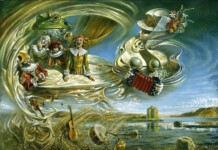- Divergent Creativity Techniques: How to Generate Non-Standard Ideas
- Freewriting — Subconscious Creative Technique
- Dream Journaling as a Technique for Finding Creative Solutions
- Free Association: A Creative Thinking Technique
- Wishful Thinking — Creativity Technique for Breakthrough Innovation
- “What if?” — A Powerful Creativity and Possibility Thinking Technique
- Role Playing as a Creative Problem Solving Technique
- Metaphor technique for Creative Problem Solving
- Reversal (Inversion) as a Creative Problem Solving Technique
“What if?” – creativity, possibility thinking and problem solving technique
1. Authors: Edward de Bono, Paul Sloane
2. History
The “What If…?” technique is rooted in Thought experimentation, which has been a staple of philosophical methodology since classical antiquity.
Aristotle used thought experiments for argumentative persuasion. In 1811 Ernst Mach introduced the word “thought experiment” (Gadankenexperiment), or the use of speculative hypotheses in philosophical problem solving. Thought Experiments in Philosophy are basically devices of the imagination.
A lateral thinking technique which was first introduced in 1967 by E. de Bono, is to write down all the dominant ideas that apply to a particular situation and then deliberately challenge them.
Edward de Bono suggested we have three possible answers to a question: yes, no, and “po.”
Po is a possibility, in the creative process. Creativity says, “what if this were the case?” without assuming it is so.
“Start with a challenge and, individually or in a group, generate a short list of really provocative ‘What if?’ Questions. Take one and see where it leads. Follow the crazy train of thought and see what emerges. You will start with silly ideas, but these often lead to radical insights and innovations.” – Edward de Bono
Paul Sloane wrote that asking ‘What if?’ is a lateral thinking technique that helps us to explore possibilities and challenge assumptions at the same time. We use the ‘What if?’ question to stretch every dimension of the issue. Each ‘What if?’ question should be extreme to point of being ridiculous.
Usually, audacious one — all great ideas tend to be, almost by definition — by asking What If…? Besides, “What if” is the universal technique of creative imagination that underlies many creative techniques. For example, Checklist SCAMPER (Bob Eberle, 1971) contains such questions as What if you combined purposes or objectives? What if you try to reverse it…?
A specific difference of the “What if?… technique” is to ask extremely bold, sometimes weird, ridiculous and absurd questions. Namely, such kinds of questions can lead to wonderful, unexpected and powerful solutions to the problem.
Moreover, this technique is used as a tool for scenario thinking. It is based on our ability to think about the future. When thinking about the future, we often engage in games of ‘what if…?’ considering optimistic and pessimistic scenarios that could happen.
Structured What If Technique (SWIFT) is a prospective hazards analysis method that uses structured brainstorming with guidewords and prompts to identify risks.
3. Description
This technique begins with an invitation to write down the questions starting with the words “What if?…” In the process of implementing this method individually or in a group, generate a list of provocative “What if” questions.
Each question should be extreme to the point of being fanciful and ridiculous. After that, answers to questions are generated and connections with the existing problem are found. A received list of the answers and associations can be used for generating new ideas and solutions.
Asking “what if” is a lateral thinking technique that helps explore possibilities and challenge assumptions simultaneously and investigate every aspect of the problem.
Examples of the bold and silly questions, which could lead to radical insights and innovations:
“What if we could fly?”
What if this problem came up 100 years ago?
What if Superman were facing this problem?
What if all humans were alike?
What if we had two heads?
4. Main functions
1. This technique can be useful in creativity, where fanciful ‘what if’ questions can spark innovative ideas and lead to fresh insights and wonderful new discoveries.
2. This is a lateral thinking technique that helps us to explore possibilities and challenge assumptions at the same time.
3. Asking “What if?” is a very effective process of activating creative critical thinking, allowing an individual or team to question the possible outcomes.
4. This technique is also helpful in assessing attempts to do something new or different or to find a so-far untried solution to a problem.
5. Methodological and theoretical grounds
Creativity involves bridging the gap between what is and what should be, with the help of imagination.
Possibility thinking or what if and as-if thinking allows us to see objects in different ways and contexts and stimulates a vision of new possibilities and perspectives.
What if questions fire our imagination, challenging accepted norms, the “rules” and the assumptions and allowing us to think without limits or constraints?
What if? line of inquiry is common to all types of innovative thinking because it sparks people’s imagination and creativity.
What if questions lie in the fact that you can use funny and unusual scenarios as a creative starting point to generate ideas? Often these mind-bubbling questions lead to fresh insights and wonderful new ideas. This method involves a much more relaxed, open, and playful approach toward the problems.
Challenge Assumptions are fundamental to lateral thinking and are a necessary exercise for reorganizing the current thought patterns to make better use of information when searching for alternative patterns.
6. Basic steps
Step 1. Generate ‘What if…’ questions.
Simply create your own long list of What if questions. You could use questions such as:
• What if… we had a million dollars to spend on the solution?
• What if you would merge with your biggest competitor?
• What if your most talented employees would leave you?
• What if a new startup starts giving your core product away for free?
Step 2. Generate Answers
Accumulate your answers and associations. Try to make a connection between your What if… scenarios and your existing situation.
Step 3. Generate ideas
Use your answers to generate new creative ideas for your challenge.
Step 4. Select ideas
Then when you have a range of possibilities, ideas and solutions start thinking more evaluatively and pragmatically, thinning them down by asking ‘what can we do’.
7. What if Group Technique
1. Ask every participant to generate his or her own list of creative ‘What if’ questions Set approximately 3-5 minutes for this first step.
2. Ask participants to write each ‘What if’ question on a separate index card.
3. Collect all cards, shuffle the cards and pick one at random. Read it out loud, and ask all participants to use it as a stepping stone to finding creative solutions.
4. Try to make a connection between your ‘What if’ scenario and your existing situation.
5. See if you can extract a principle or find an interesting insight to work on.
8. Advantages
- This technique encourages creative thinking and imagination and allows individuals or teams to explore a wide range of possibilities and scenarios.
- It can help overcome mental blocks and break out of conventional thinking patterns.
- It can foster collaboration and communication within a team as they work together to explore different ideas and scenarios.
9. Limitations and disadvantages
- It may not be suitable for all types of problems or situations. For example, it may not be effective for complex technical problems that require a more structured approach.
- It can sometimes result in unrealistic or impractical ideas, which may not be useful in solving the problem at hand.
- It may not work well if individuals or teams are not willing to fully engage in the process or if there is a lack of trust or open communication.









